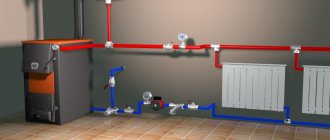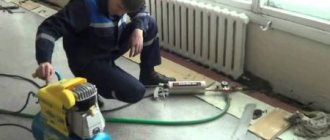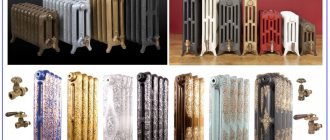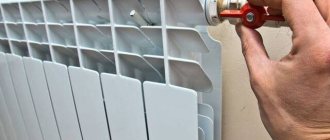What to do if uneven heating is caused by incorrect battery connection
Improper installation of radiators leads to inefficiency and loss of heating performance. A similar mistake is made by inexperienced builders who simply confuse the return pipe with the supply pipe. That's why you need to call a professional plumber to install your heating system. As a result of incorrect connection of pipelines, the following problems occur:
- the direction of water flow changes;
- the efficiency of the cast iron battery decreases;
- the outflow of coolant changes;
- there is a risk of destruction of the upper part of the heating device.
In an incorrectly connected battery, the coolant enters the element through the lower pipe. With this connection, the liquid cannot warm up all sections, so its efficiency is reduced significantly compared to the correct connection of the device. According to the laws of physics, hot water, just like heated air, rises, so the lower part remains cold.
With proper installation of heating in a private home, the heated liquid passes through the regulator and enters the upper part of the heating device. Through slight pressure, water penetrates into the lower part of the battery, that is, it fills the entire usable space of the sections. In this case, the heating system will be configured for maximum heat transfer.
Important! To solve the problem, disconnect the radiator from the circuit and swap the pipes.
Why is the top of the battery hot and the bottom cold?
Almost all batteries have a hot top and a cold bottom. These are the operational features of radiators. They are associated with a large percentage of heat transfer in the heating system. The liquid inside cools down before moving further through the pipes. But the difference in temperature should not be significant. According to the standards - no more than 5 degrees. For independent measurements, you can use a special thermometer (mercury or electronic) so that its scale is calculated up to +80 degrees and above. Just apply the part of the thermometer that contains mercury to the radiator, fix it and wait for the result.
Using thermometers for heating radiators, you can determine whether there is a problem with the battery. If the temperature difference between the top and bottom of the radiator is no more than 5 degrees, this is an operational feature
However, if the battery at the bottom is very cold and the top is too hot, then the problem is not in the technical characteristics of the equipment. Most likely the reason is the following:
- during the installation of the heating system, the installer mixed up the pipelines that are responsible for the supply and return of internal fluid (water, oil, antifreeze);
- the liquid circulates too slowly inside the structure, it cools down on approaching the coolant and becomes icy the moment it leaves the battery;
- The pressure in the heating system has dropped.
If the structure is connected incorrectly, the result is:
- the circulation of fluid in the system is disrupted;
- efficiency approaches zero;
- the liquid does not enter all sections without exception, which is necessary for normal battery operation;
- water, oil or antifreeze does not come out at all or leaves the radiator unevenly;
- high pressure is created inside the heating system, which can lead to rupture of pipes and connections.
If the coolant fluid circulates in the structure too slowly, then the battery is cool from below. The problem occurs due to the following reasons:
- the pipes are too narrow and not suitable for the specific system;
- the pump failed during operation or did not correspond to the power of the system at all;
- soldering of pipes was carried out in violation of standards.
If the pipes are soldered in violation of the standards and requirements, the radiator will be hot at the top and cold at the bottom.
Related Posts
- Connection diagrams for bimetallic radiators
- Major heating repairs in an apartment building
- Using narrow, low and compact heating radiators
- Benefits of using a duct extension for radiators
- Radiator plugs: installation nuances
- Comparison of heating radiators by heat transfer
- Leningrad heating system for a private house
- Which heating radiator is best for a private home? heating calculation and equipment selection
- How to make steam heating
- Heating battery does not warm up
- How to choose and install an air valve for heating
- Calculation of space heating
- Hydroarrow: principle of operation, purpose and calculations
- Why does the air conditioner gurgle when not working when there is wind?
- Is it possible to paint the battery during the heating season?
- Subtleties of crimping a heating system
- Thermal power
- What paint to choose for heating radiators and how to paint them
- At what temperature of the coolant is the heating system turned off and turned on in an apartment building according to GOST
- Tichelmann loop
- Metal radiators
- How to close the battery beautifully and correctly
- A supply of hot water that is always at hand: how does an electric water heater for heating work?
- Installing a heating bypass: 15 photos with the process and examples of work
- GOST 25136-82 connection of pipelines. leak test methods
Read with this
- Connection diagrams for bimetallic radiators
- Major heating repairs in an apartment building
- Using narrow, low and compact heating radiators
- Benefits of using a duct extension for radiators
- Radiator plugs: installation nuances
- Comparison of heating radiators by heat transfer
- Leningrad heating system for a private house
- Which heating radiator is best for a private home? heating calculation and equipment selection
- How to make steam heating
- Heating battery does not warm up
Other reasons
The most popular reason is a decrease in the coolant flow rate. There are several options why this problem occurs:
- Narrow pipe section. Narrowing of the pipe can occur due to improper soldering of the pipes. This applies to polypropylene pipes. Another possible cause could be the presence of any deposits in the pipe. A common problem encountered is the installation of a control valve with a narrowed cross-section;
- In a heating system, the coolant moves at low speed. This problem occurs when the power of the circulation pump is low. In this case, the water does not move at the required speed and cannot go into the layer. This problem mainly occurs in gravity systems, in which there is no additional equipment;
- Low temperature in the house. In this case, the radiator cools faster, as it gives off a large amount of its energy. Therefore, the bottom of the radiator becomes colder than the top.
To identify the cause, the condition of the entire heating system should be assessed and checked. Once a problem is detected, it must be corrected for further normal operation of the radiator.
How to determine the optimal connection diagram depending on the number of sections?
The number of sections of a bimetallic heating radiator directly affects the choice of connection diagram. For example, for models with up to 8 sections a side, diagonal or bottom saddle connection would be optimal . If the number of sections of a bimetallic heating radiator is more than 8 , then you should choose a diagonal connection diagram .
However, there are some tricks that allow radiators with 9, 10 or more sections to be connected laterally. To do this, you need to use a so-called flow extender.
What is a flow extender and how to install it correctly?
A flow extender is a tube that is inserted into the supply manifold . It is advisable to use this device if, with a lateral connection, only the first sections of the bimetallic heating radiator turn out to be hot, while the rest remain slightly warm.
When using a flow extender, it is possible to ensure conditions under which the coolant will be supplied not to the input of the device, but a little further (conventionally, to the central part), due to this, more uniform heating of the surfaces of all sections of the radiator is ensured.
If, when connecting a bimetallic heating radiator, you decide to use a flow extender, then it is important to know what length of the device will be optimal . This parameter is determined depending on the number of sections. There are actually two options:
- The extension cord should be 2/3 of the total length of the radiator.
- The length of the extension should be such that it reaches the middle part of the last section.
In this case, you need to choose an option through experimentation. For example, in some cases an extension cord reaching halfway into the last section will not allow the first sections to warm up to the same degree as the last ones. If you are faced with such a situation, do not worry, because the problem is easily solved: just shorten the tube. Experts advise always purchasing an extension cord “with a reserve” so that, if necessary, it can be shortened: obviously, nothing can be done with a device that is too short. And which option is suitable (2/3 or to the middle of the last section) directly depends on the diameter of the liner, as well as the pressure in the riser.
Second point: if you decide to use an extension cord when connecting a bimetallic heating radiator, you can make holes in it. This “trick” will help ensure conditions under which the coolant will flow evenly and be distributed throughout the vertical collectors. However, it is not at all necessary to do this; the extension cord copes with its functions perfectly without holes.
How to clean clogged batteries?
To avoid a situation where the radiators are cold on the bottom and hot on the top, they need to be cleaned periodically:
- To clean the radiator, it will have to be removed and washed. The best place for this would be the street or the bathroom.
- If you plan to clean the bathroom, protect the drain from blockages and the bathroom from scratches.
- Turn off the water, remove the radiator, drain all the liquid.
- To remove the rust, tap the battery through a thick cloth, then shake out the debris.
- It would be a good idea to rinse the battery with a pressure hose to properly clean it of accumulated rust.
- For prevention, you should clean all radiators in the apartment, and not just those where the lower part of the radiator is cold and the upper part is hot.
- Be careful when cleaning the battery. If you doubt that you can handle this work, it is better to contact a specialist.
Now you know what to do if the top of the battery is hot and the bottom is cold. On our website you can find out where to complain in Moscow about cold radiators in your apartment.
Experts explain why the batteries are cold and the riser is hot
You can't warm your hands on cold radiators.
There can be many reasons why the coolant supply pipe is hot and the radiator is cold. For general development, specialists name only the main ones:
- the central valve on the heat supply line is closed or the return line is closed;
- insufficient coolant flow;
- airing of the system or a specific riser, radiator;
- the heating system is not balanced;
- contamination in the heating circuit;
- reducing the cross-section of the coolant supply pipe.
However, the following actions by the residents of the house will help the technicians who come to the call to quickly eliminate the malfunction of the heating circuit:
- Is it necessary to install a hot pipe and a cold radiator in only one apartment or does this problem affect the entire riser. Perhaps the heating wiring of the entire entrance is faulty;
- it doesn’t hurt to go around all the entrances and see if the heating elements are hot there;
- you can go down to the basement and inspect the pipes for breakdowns. Even a drip leak leads to a drop in pressure in the system. This adversely affects her work.
All information received should be passed on to specialists. However, there are situations when the organization involved in heating the house refuses to repair the wiring. In this case, residents must contact regulatory authorities with a complaint about poor quality services. Also read: “Where should I go if the batteries don’t heat up?”
Everything you need to know about filling your heating system with antifreeze can be found here.
Device for cleaning the circuit.
If the batteries do not heat up the riser. If the riser is cold, the battery is cold - this is a sure sign that the main line through which the coolant flows is blocked. To confirm this, you need to walk through the neighboring apartments. They should warm up well. In this case, only a plumber, who will have drawings of the heating wiring of the house, can fix the breakdown.
The following state of affairs, when the pipe is hot and the battery is cold, indicates a blockage in the system or the presence of an air lock. It prevents the penetration of coolant into the heating element. As a result, the latter does not warm up. Blockages can only be eliminated if you completely disassemble the radiator and force air through it under pressure. This can only be done by a specialist who has the necessary tools and equipment.
It is easy to eliminate an air lock that prevents the full circulation of coolant in the system. For this purpose, each radiator is equipped with a Mayevsky tap. It is enough to open it slightly and let out some hot water. Along with it, unnecessary air will come out. Also read: “What to do if the batteries don’t heat up?”
All the nuances that you may encounter when installing an electric boiler in a heating system are described at this link.
If the radiators in the entire entrance do not heat
When the heating radiator is cold and the riser is hot, you need to pay attention to the pressure in the circuit. If the pressure is insufficient, the coolant cannot pass through all the radiators in the circuit
As a result, the batteries lower their temperature as they move away from the heat-carrying main. Residents of the house cannot increase the pressure in the system on their own, and therefore it is recommended to seek help from professionals. More specifically, call the organization that is responsible for the heat supply of the building.
The supply and return may be reversed.
Residents of a new house, when starting up the heating system for the first time, may observe the following situation: the battery is cold and the return is hot. Here it is appropriate to assume that errors were made when installing the heating elements. In this case, the pipes supplying coolant and the return circuit are swapped. If we are talking about an individual heating circuit, then it is worth taking a closer look at the circulation pump. It may not be installed correctly.
When asked why there is cold return in the radiators, experts clearly point to an incorrectly designed heating system. In some cases, it is appropriate to talk about low coolant flow.
Problems with the radiators themselves
Why is the radiator hot on top and cold on the bottom and how to fix it?
The bottom of the battery is clogged with dirt

The lower part of the radiator is clogged with dirt.
- First, check the heating pipes in your apartment . When they are warm, ask your neighbors.
- When everything is in order with them and with the heating wiring, as well as with the radiators, it means that the problem is in your device.
- Most often, the reason is that it is clogged with dirt - metal oxides (rust) and other suspended matter, which, when settled, do not allow the coolant to pass through. Therefore, the top of the radiator is hot and the bottom is cold.
- Try warming up the battery in the problem area . The water will boil there, begin to move, and perhaps the suspension will leave.
Note! Of course, a more effective way to clean the battery is to remove it and wash it. However, you cannot do this work yourself, because... you will have to disconnect the entire heating riser from the water. Housing office workers will refuse to do this in the winter cold. Therefore, the batteries should be washed in advance, before the start of the heating season.
Air in heating devices

Air bleed valve.
Often batteries do not heat well, because... an air plug was created in them. It is formed when the coolant heats up and suddenly fills the heating system with it.
The heating radiator does not warm up in an apartment or private house
Do you think that the heating radiator is not heating well? There is only one reason: hot water does not flow into the radiator. There is no unambiguous algorithm for selecting subsequent solutions. Only a qualified specialist will be able to unbiasedly understand the current situation and give suggestions regarding your heating system. However, before you decide to call a plumber, there is a lot you can do yourself.
Maybe the neighbors are to blame?
It may sound trivial, but first make sure that you have hot water in your home, whether the tap is open for it to flow, or the riser is closed due to plumbing work in the basement. Don’t be too lazy to run through your neighbors on the upper floors. In the event of unprofessional repairs, some of them will have a comfortable radiator temperature, but all the residents below the riser will not receive heat and will be cold.

You have every right to come in like a neighbor with the question “the batteries are not heating: what to do”, and at the same time check their heating temperature. If you find a battery that is warmer than yours, then the problem that has arisen may turn out to be just an incorrect installation of the valves at your neighbor’s. Your further actions will depend on the situation; perhaps the shut-off valves, which deprived other neighbors of comfort, will be removed without a scandal. Or call your housing and communal services structure and, with the help of the administration, restore civil justice.
Briefly about the heat supply of an apartment building
If you have the courage to figure out on your own why the batteries do not heat well, it would be a good idea to familiarize yourself with the basic concepts associated with heating a residential apartment building.
Most high-rise buildings use a single-pipe system equipped with U-shaped risers. Let us show a conditional diagram of the heat supply of three floors.
Hot water (red in the diagram) rises through one riser and passes, for example, through the bedrooms, to the top floor, where, in a loop, it goes down through other rooms (blue). This scheme has been designed since Soviet times for the use of cast iron radiators. Hot water enters the lower radiator manifold and, after passing through all sections, leaves the battery through the upper manifold.
A special role was given to jumpers (bypasses). They maintained general forced circulation throughout the entire pipeline of the U-shaped riser (in the diagram - for the six radiators shown), acting as a safety net in cases of radiator clogging with liquid technical dirt that accumulates during many years of operation. When passing through the riser, some part of the total displacement of hot water supplied from below turned to the radiator on one floor, and the rest passed by unhindered, delivering heat to the apartments adjacent to the riser.
The aluminum heating radiators that have appeared are designed for two-pipe systems with hot water supplied through the upper collector and its output from the lower collector. They have a completely different design of the internal cavity, and accordingly, different hydraulics. When they began to indiscriminately replace obsolete cast iron radiators with modern aluminum ones, but maintaining a single-pipe design, the heat flow from hot water inside the radiators began to weaken due to the mismatched directions of convection heat flows from the cooling water and the hot water pumped by an external pump.

Bypass
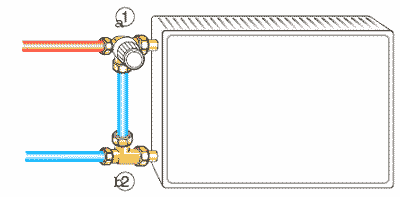
The bypass is the same pipe that stands in front of the installed heating device. Everyone has one, it’s needed to bypass water past the battery. If installed incorrectly - too far from the radiator, or in line with the central riser, it does not allow water, which tends to travel along the shortest path, to circulate normally, heating the radiator sections. In this situation, they will either not heat at all or will be very bad. Check how your bypass is installed. Perhaps this is the direct reason why the batteries do not heat up
Useful tips
If the batteries are cold, and the most likely reason for this is the presence of an air lock, then experts do not recommend draining the coolant from the system. On the contrary, its constant circulation will facilitate the removal of air using relief valves.
In individual properties, the heating system has an expansion tank. In order to prevent the occurrence of air locks, you can weld a tap to the lower pipe through which you need to fill the system with water.
It should also be taken into account that all kinds of decorative screens for heating devices are at the same time an obstacle to the passage of warm air masses. The exception, perhaps, is metal products, since this material has good thermal conductivity. Study brick stoves for your dacha with your own hands at the link.
Basic malfunctions of heating systems and their elimination
Air jams
Air pockets occur in radiators and pipes and interfere with the normal circulation of water in the heating system. They appear for various reasons:
- violation of the technology for filling the system with water after the summer period;
- non-compliance with water deaeration regime;
- performing repairs with disassembling pipelines;
- failure to observe slopes when installing the heating system;
- air leakage through leaky joints.
To remove air from the system, use a Mayevsky valve installed on the radiator. You should open it, wait until the air comes out, the hissing stops, and the water begins to pour out calmly without bubbles. After this, the valve is closed. Don't forget to provide a container or towel to drain the water.
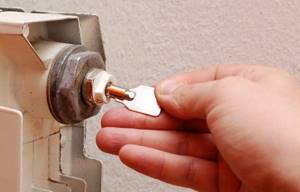
Old cast iron batteries do not have Mayevsky taps. The air is released without completely unscrewing the plugs at the ends of the radiators. It is better to entrust this operation to plumbers - if you unscrew the plug completely, you can flood the apartment.
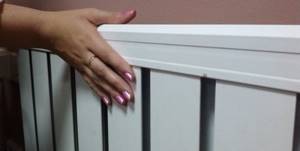
In the cold season, the main thing is good heating. Unfortunately, not all houses in winter remain at a comfortable level.
This applies to both multi-apartment housing and the private sector. Why is this situation happening and what to do?

